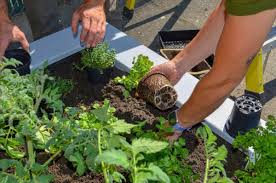Gardens Can Be Beautiful Anywhere

The Nevada desert, known for its harsh climate and water scarcity, might not seem like the ideal location for a vegetable garden. However, with the right strategies and a little perseverance, it is possible to cultivate a thriving and hardy vegetable garden even in this challenging environment. In this article, we’ll explore the key factors to consider when planning and maintaining a desert vegetable garden, from choosing the right plants to optimizing irrigation methods.
1. Selecting the Right Vegetables: To establish a successful garden in the Nevada desert, choosing vegetables well-adapted to arid conditions is essential. Some ideal options include:
– Tomatoes: Sun Gold and Heatmaster are specifically bred to withstand high temperatures and low humidity.
– Peppers: Hot pepper varieties, such as jalapeños and habaneros, thrive in heat and require less water than bell peppers.
– Swiss chard: This leafy green is hardy and can tolerate various temperatures.
– Okra: A heat-loving vegetable that can be grown in the hottest parts of the desert.
– Melons: Desert-adapted varieties like ‘Cantaloupe’ and ‘Watermelon’ can thrive in the Nevada climate with proper care.
2. Soil Preparation and Amendments: Desert soil can be challenging to work with, often containing high salts and poor water retention. To enhance the fertility and structure of your garden’s soil, consider these amendments:
– Compost: Organic matter such as compost improves water retention and adds essential nutrients to the soil.
– Gypsum: Adding gypsum can help to break up compacted soil and flush out excess salts.
– Mulch: Putting a layer of mulch around your plants will help retain moisture and moderate soil temperatures.
3. Water Management and Irrigation:
Efficient water use is crucial for desert gardening. Adopt these strategies to optimize irrigation:
– Drip irrigation: This method conserves water by delivering it directly to the plant’s roots, minimizing evaporation and runoff.
– Water in the early morning or late evening: Watering during cooler periods of the day reduces evaporation losses.
– Monitor soil moisture: Avoid over-watering by monitoring the soil’s dampness using a moisture meter or feeling the ground with your fingers.
4. Shade and Wind Protection: Desert gardens often contend with extreme temperatures and intense sunlight. To protect your plants from these harsh conditions, consider the following:
– Installing shade cloth: A shade cloth with a 30-50% shade rating can help protect your plants from sunburn and excessive heat.
– Windbreaks: Adding windbreaks, such as tall plants, fences, or walls, can reduce the impact of solid desert winds on your garden.
5. Pest and Disease Management: Desert gardens can be vulnerable to pests and diseases. Maintain a healthy garden by:
– Encouraging beneficial insects: Ladybugs, lacewings, and parasitic wasps can help control pest populations naturally.
– Practicing crop rotation: Rotating crops each season can reduce the danger of disease and pest infestations.
– Applying organic pesticides: Use organic pesticides like neem oil or insecticidal soap only when necessary and follow label instructions.
Growing a successful vegetable garden in the Nevada desert may present unique challenges, but a thriving garden is within reach with proper planning, plant selection, and care. By considering the specific needs of the desert environment and implementing adaptive strategies, you can defy the odds and enjoy a bountiful harvest in the arid landscape of Nevada.
